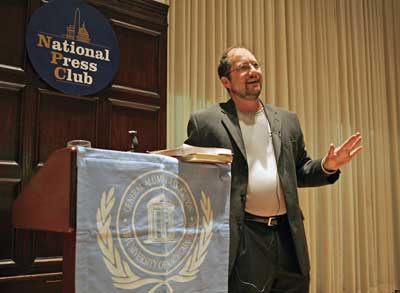GAA Brings Professor to D.C.-area
Posted on Dec. 6, 2006
Photo by Mark Abraham.
Dan Brown’s The Da Vinci Code flew off the shelves. Mel Gibson’s The Passion of the Christ had people flocking to the box office. While all this media attention on the Bible and its teachings is music to a religion professor’s ears, Bart Ehrman wonders if enough of us know fact from Hollywood fiction.
The GAA brought Ehrman – author of 20 books, including The New York Times bestseller Misquoting Jesus: The Story Behind Who Changed the Bible and Why and Truth and Fiction in The Da Vinci Code – to the National Press Club in Washington, D.C., to speak to area alumni and friends in November. Ehrman is UNC’s James A. Gray Distinguished Professor of religious studies and chair of Carolina’s department of religious studies. He shared with his audience of nearly 200 an informal poll he recently conducted. He had asked a class of 350 students if they agreed that the Bible is the inspired word of God. “Voom! The entire room raises their hands,” he remembered. How many have read all of The Da Vinci Code? Again, almost all hands up. How many have read the entire Bible? Scattered hands went up, he said.
“A lot of people have gotten their information from, their knowledge of the past, from these modern presentations,” Ehrman said. “But how much can you trust of it?” Beaming at the room of filled chairs, Ehrman enthusiastically began to set the record straight.
There are lots of gospels that did not make it into the New Testament. Fact. The Da Vinci Code says 80 books were vying for a spot in the New Testament. But Ehrman says the known number is closer to 35 or 40, including the newly discovered Gospel of Judas, about which Ehrman wrote his most recent book, The Lost Gospel of Judas Iscariot: A New Look at Betrayer and Betrayed.
The gospels that didn’t make it into the New Testament are more reliable than those that did. Fiction. Though the four gospels that appear in the New Testament do have some historical problems, Ehrman says, they’re still more historically accurate. Ehrman offers one unlikely example from the omitted Gospel of Peter, where an account of Jesus rising from the dead includes a super-sized Jesus and a talking cross. “This is a terrific account, but I don’t think anyone’s going to want to say if you’d been there, you’d have been able to capture it with your video camera,” he said.
Gospels not included in the New Testament regularly indicate Jesus was married to Mary Magdalene. Fiction. “In no gospel outside the New Testament is there any reference of any kind to Jesus being married to Mary Magdalene,” Ehrman said. “Absolute fiction.”
Mel Gibson’s Passion is a reliable account of what was narrated in the New Testament and what actually happened. Fiction. Ehrman points to the extended blood and gore in Passion that made up Jesus’ last 24 hours. “The gospels talk about Jesus being flogged in four words,” Ehrman said. ” ‘And he was flogged.’ Boom. That’s it.”
The Gospel of Judas is the most important discovery of a Christian text in the past 60 years. Fact. Ehrman said this gospel will be significant for a long time because it opens questions of what Judas did and why.
With the facts set, Ehrman fielded questions from the audience. Religion is an obvious topic to spark passionate disagreements, but this event simply opened thoughtful discussion, said Ailis Aaron Wolf ’99, of Alexandria, Va. “I grew up going to Catholic school my entire life before going to Carolina so it offers other perspectives on things that I’d always been taught to be a certain way,” Wolf said. “Hearing the other perspective is interesting.”
The GAA invites alumni and friends to hear Ehrman speak at upcoming events in Los Angeles, San Francisco and Chicago. Details are available online.
–Lynne Shallcross ’04
Related coverage is available online:
- The Happy Agnostic – His own faith a little beaten up, the prolific author Bart Ehrman never tires of probing beneath the rocks of religious belief.
Feature coverage from the May/June 2006 issue of the Carolina Alumni Review, available online to Carolina Alumni members.
